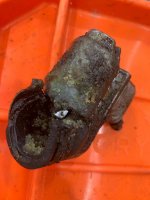Silicone itself is
made up of carbon, hydrogen, oxygen and
silicon. Note that the ingredient contained within
silicone is spelt differently. The ingredient
silicon comes from silica which is
derived from sand. ... It's then mixed with the other chemicals to create
silicone.
See;
https://silicone.co.uk/news/where-does-silicone-rubber-come-from/
I know the difference. It was a bit of a stretch, but because silicone is a compound containing silicon, I speculated that it
could crystallize--
"crystallization wouldn't be surprising"--though I've not seen it happen. Silicone is great stuff, I use a 'dry silicone' lubricant where a light lubricant is required--e.g. speedometer cables and starter worm gears--as it doesn't seem to attract dirt and gunk-up as much as petroleum-based lubricants and, of course, it has certain, er, 'cosmetic' applications.
I mentioned that I had DoT 4 gel in my BN2, and I'm replacing a wheel cylinder that appears to be crusted with the same sort of substance shown in OP's photo, but dried out. It appears this may be a common problem, and I'd like to figure it out. If the owners all used DoT 4, then the borate esters--I also know the difference between boron* and borate--could be the culprit, since DoT 3 doesn't contain borate esters (presumably, DoT 3 was originally spec'd for our 50s-era cars, but there was a DoT 2). DoT 3 would be sufficient for our street-driven cars, though racers might prefer DoT 4, 5 or 5.1.
* Incidentally, there's a town--actually, a 'census-designated place'--called Boron in California, home to a large open-pit boron mine. You wouldn't want to live there.

 Hi Guest!
Hi Guest!

 smilie in place of the real @
smilie in place of the real @
 Pretty Please - add it to our Events forum(s) and add to the calendar! >>
Pretty Please - add it to our Events forum(s) and add to the calendar! >> 

